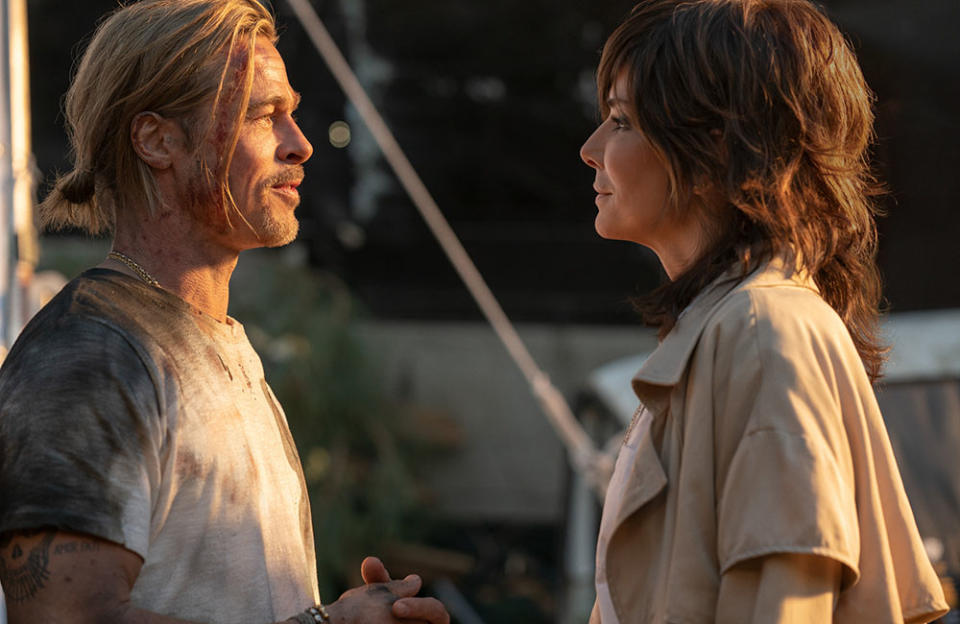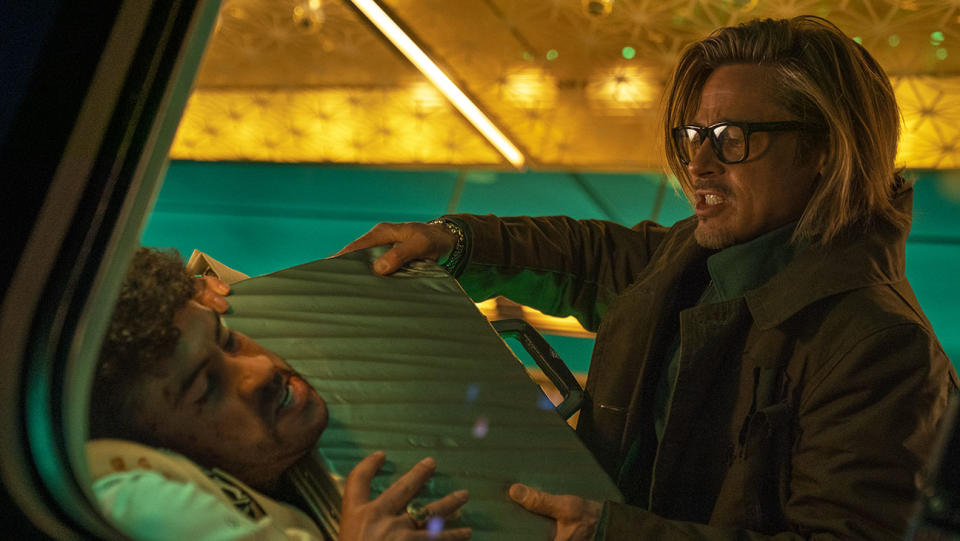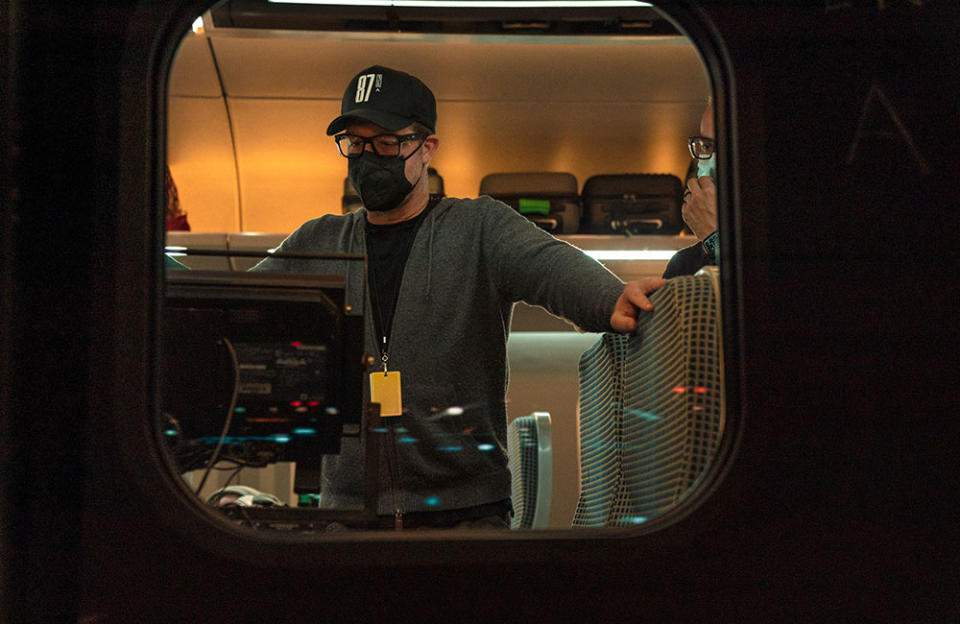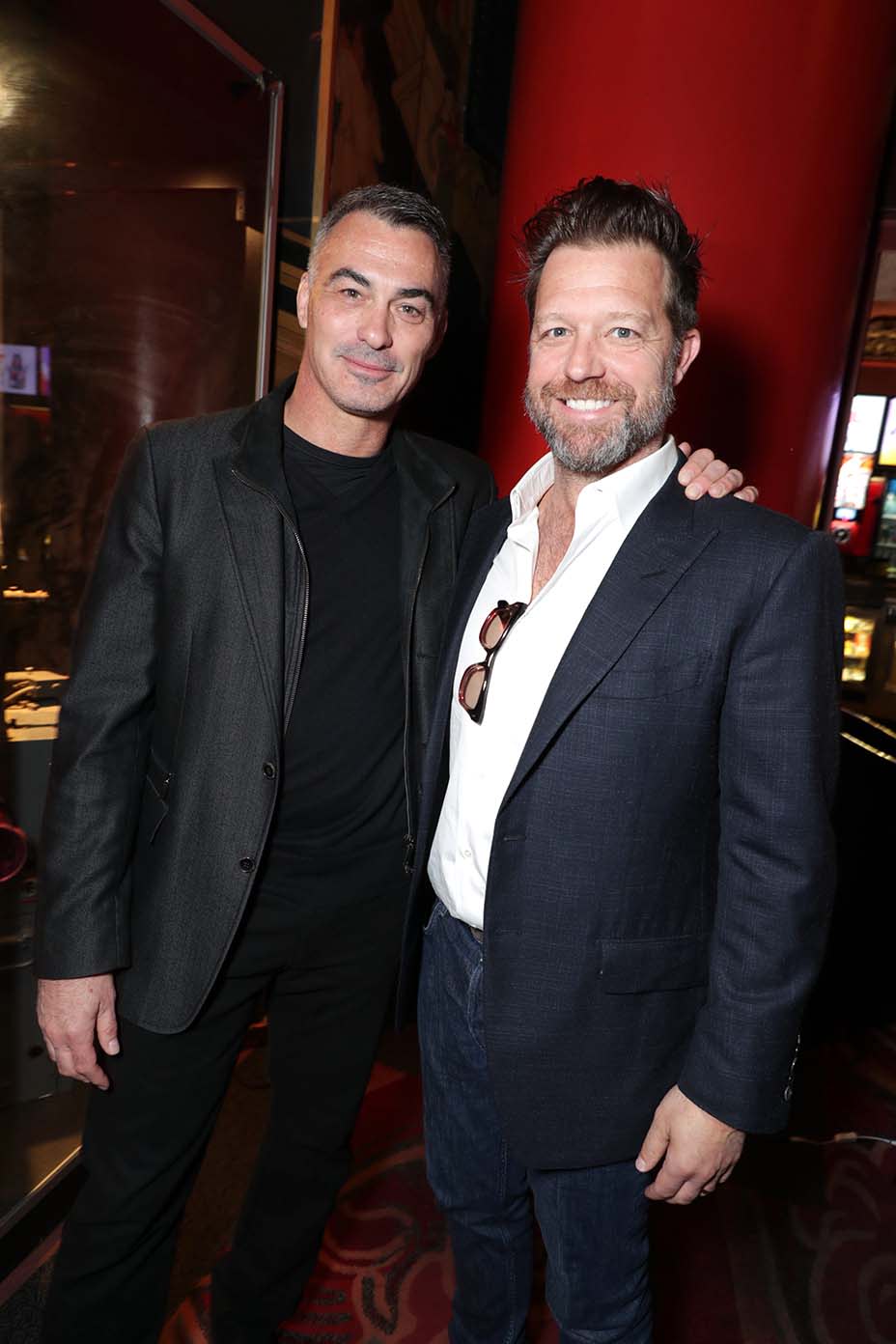How ‘Bullet Train’ Director David Leitch Went From Brad Pitt’s Stuntman to Brad Pitt’s Director
- Oops!Something went wrong.Please try again later.
- Oops!Something went wrong.Please try again later.
- Oops!Something went wrong.Please try again later.
- Oops!Something went wrong.Please try again later.
- Oops!Something went wrong.Please try again later.

David Leitch first worked with Brad Pitt in the late ’90s when he doubled for him on the set of David Fincher’s Fight Club. The experience went so well that Pitt soon recommended him for the same role on Gore Verbinski’s The Mexican, but within a day, Leitch totaled two El Caminos during a driving stunt on set. So even though the second experience didn’t go as swimmingly as the first, Leitch and Pitt still bonded over this disastrous moment and laugh about it to this day.
Since their last collaboration on 2005’s Mr. and Mrs. Smith, Pitt has been watching Leitch climb the ranks from stunt performer and stunt coordinator to second unit director and ultimately director of Deadpool 2, Atomic Blonde and Hobbs & Shaw. So when Leitch reached out to his former collaborator (and Deadpool 2 cameo) regarding the assassin action-comedy Bullet Train, Pitt was eager to team up again and explore a completely different working relationship this time around, as actor and director. Admittedly, it took Leitch and Pitt a minute to adjust to their new dynamic.
More from The Hollywood Reporter
'Bullet Train' Star Zazie Beetz Discusses Fighting Brad Pitt, 'Joker' Fate and 'Deadpool' Future
Events of the Week: 'Bullet Train,' 'A League of Their Own' and More
“There were small growing pains, but it was actually pretty quick,” Leitch tells The Hollywood Reporter. “I was excited and blown away by how he had been following my career once we left each other and I started to move into second unit directing and directing. So he appreciated what I was doing, and when I called, he was excited to collaborate again.”
Leitch has also been focused on developing his production company, 87North, alongside his producing partner and wife, Kelly McCormick, and the two are currently making progress on a sequel to Bob Odenkirk’s well-received actioner, Nobody.
“I think that movie is going to happen. The will is there from Bob, the studio, the producers, Derek [Kolstad, the screenwriter] and ourselves,” Leitch says. “So we’re in development on it, like hard-core development on it, and I would place your bet on it.”
In a recent conversation with THR, Leitch also discusses his tendency to include numerous cameos in his films, before explaining why he has yet to see John Wick 4.
Well, based on your last three films, you’ve become quite the cameo whisperer.
(Laughs.) I like to provide a fun experience for the audience, and I want to make movies that you want to go to the cinema to see, especially if you want to laugh, be shocked and have feels. No matter what genre I’m playing in, I’m trying to blend all of those things. So I guess I enjoy a good cameo for that communal shock experience. When people go to the cinema, they pay money to be entertained, and there’s something that’s just fun about seeing another celebrity jumping on the screen for a moment. And if we did it in any other way — like a streaming movie or a television show — it just wouldn’t feel the same way as sharing that surprise at the cinema. It’s fun.

We thought Sandra “Sandy” Bullock would be the cameo, but it seems like you and Brad took an all-hands-on-deck approach. And based on your recent collaborations, I think I can recognize who called who.
(Laughs.) We were first out of the gate early on in the pandemic, and we ended up being released later on. And so the way favors can be exchanged, it might have actually been in reverse order.
I have no idea how you landed the actor who plays Jeff Zufelt [Leitch himself]. I hear he drives a hard bargain.
(Laughs.) A very, very hard bargain!
So you doubled for Brad back in the day, which is quite a thing to be able to say. Do you have a memory from those days that epitomizes your actor-stuntman collaboration?
I have plenty of specific moments that endeared us to each other. We had a fun moment on The Mexican where he was supporting me coming down. It was the second job I did with him, and he was talking me up to the crew and to the director, Gore Verbinski. And once I got down there, within 24 hours, I crashed the El Camino into the other El Camino by accident and destroyed both cars. (Laughs.) So we get to laugh a lot about that now, but we had a lot of great bonding moments. We did a lot of action together, a lot of fights together. Troy was a six- or seven-month experience traveling around the world, and we shot in London, Malta and Cabo. So the training for that movie was grueling, but you do form a great bond.
When you saw Once Upon a Time in Hollywood, did you recognize any elements from Brad and Leo’s stuntman-actor relationship?
We talked about that on the European tour for a brief moment. He portrayed an incredible stuntman, but it’s a stuntman from a different era. It’s more like what Hal Needham and Burt Reynolds had. So I wasn’t picking up Brad in a car and going down to Hollywood Boulevard to drink Bloody Marys. The business really changed, so it was more professional and we were more performance-driven. I was there on set, choreographing for him, choreographing the fight training and rehearsing with him in the fights and just getting him ready and helping him build a character. And a lot of it was all on set. We were living the set life. Our personal lives never intertwined like they did in Once Upon a Time.
Going from his double to his director, did it take a minute for the two of you to become accustomed to this new dynamic?
There were small growing pains, but it was actually pretty quick. He’s such a gracious collaborator, and we did have this history of four or five movies together and literally three years of our lives on sets where we’d built the dynamic of helping him create a character. So it was really beautiful to come back together when he’s at the height of his career and the height of his character-making, and sculpt a character that’s supporting my movie. That was just a really beautiful, humbling experience. And I was excited and blown away by how he had been following my career once we left each other and I started to move into second unit directing and directing. So he appreciated what I was doing, and when I called, he was excited to collaborate again.

I know Brad likes to reference characters and actors from the past as he builds his characters, so who did you discuss? And I know this is reductive, but did the Coens or Lebowski come up at all? I couldn’t help but think of him during line deliveries like, “I don’t even know you, man!”
For me, there are definitely elements of Lebowski and the Coen brothers’ characterizations of characters, like how they sometimes find these beautiful, human moments, but also in slightly heightened characters. They’re just so skilled at that. But Brad had a real clear vision of Ladybug from the beginning, and some of it was on the page. That line, “I don’t even know you, man!” was on the page, and I think that was his jumping-off point. He wanted to create an underdog that had taken some time off to recover from a trauma at work, and that was where he expanded. He’s done therapy, but he hasn’t done the hard work of really understanding it. But he’s got all the catchphrases and he’s going to apply these catchphrases to a group of assassins on a train, and we’re going to watch it all go haywire. That was the big idea that he came with, and it makes the character fun and more relatable. It helps make him an underdog and adds to the chump factor that he really wanted to put onto this character. He was like, “Ladybug is a chump. He’s got to be a chump.” And he certainly brought the chump.
In addition to Brad, Bullet Train has a stacked ensemble cast, and we’re seeing more and more examples of this lately with original films such as Knives Out, Oppenheimer, Don’t Look Up, etc. And in this era where there are very few Brad Pitt-type movie stars left, do you think all-star ensembles are the new “movie star,” so to speak?
Hmm. Yeah, maybe. I’m not sure you can ever replace the golden age of the movie star — and maybe we’ll come back to it — but this era of superhero movies and the characters and the suits have become just as powerful as the actors playing them, to audiences. So that’s a really insightful thing. Stacking the deck with great actors that have a presence is a way to draw the audience to the cinema at this time, with the expectation of a big summer movie. I’ve never really thought of it that way, but it’s a really interesting take on it.
You touched on this, but I’ve also wondered if original movies are taking a page out of the superhero team-up movie playbook and going for a strength in numbers approach.
Well, you obviously want to do everything you can because there’s a lot of investment in a movie, especially if you’re trying to do a big summer release and compete with the likes of superhero movies and tentpole sequels. So you do want to stack the deck; it just makes sense. You want to find actors that can reach a wider audience. You need to gather that audience to give back this investment of this big summer movie, but that’s not to be mercenary about it. It’s also really beautiful. It allows for you, as a storyteller, to make the story really inclusive and have people from different generations and ethnicities, with different sensibilities, come together and tell the story in a compelling way. You challenge yourself as a storyteller to look at stories that way, and I think that’s an opportunity for guys like me.

You’ve been a part of countless action movies, so you’ve encountered every scenario under the sun. But if you had to pinpoint a first on Bullet Train, was it having to operate and design action within a confined space for most of the movie?
Yeah, it was daunting, especially coming out of Hobbs & Shaw and the Fast world where the scale is unbelievable and the physics don’t matter. With Bullet Train, I had to make a compelling summer movie inside a tube. You’re like, “What?” (Laughs.) But that’s the challenge. So you work closely with the art department to create really fun environments, like the Momomon car, and then you kill somebody with a plushy. And then you find the quiet car, which is a really fun idea that came from my first conversation with the studio and Tom Rothman, who pitched this idea to me. I definitely believe the best idea wins, and there I was taking this creative idea from Tom, the head of the studio. “What would fighting inside a quiet car look like?” And it was perfectly on tone for what we were trying to do, with the broad Buster Keaton and Jackie Chan comedy element. And when he gave me that thought, I knew that Tom knew the movie I was trying to make. So as a filmmaker, it was great that we hit it off.

So how many times has [your John Wick co-director] Chad Stahelski seen Bullet Train, and how many times have you seen John Wick 4?
I’ll be honest right now. I’ve been talking with Chad this week, but we have been extremely busy in our separate paths. So Chad has not seen Bullet and I have not seen John Wick 4.
Wow.
Chad is going to be at the L.A. premiere on Monday [Aug. 1], so I’m excited for him to see it. Normally, that wouldn’t be the case. We love to get together in post and see each other’s work and give each other thoughts, but our schedules were on different paths with these movies. So it was really hard to connect.
Given the number of assassin characters you guys have created in your various movies since the first John Wick, do you ever have to touch base with each other to make sure you’re not overlapping?
We do, but I don’t think we’ve ever had to do that. If we had a movie that was closer in tone, we might want to just check in and go, “Hey man, I’m doing this movie. The tone is this, and I think you’re doing something like this, so let’s talk.” But with Bullet Train in particular, it was so broad and bombastic, and he’s been really head-down in the Wick world that I knew we were far enough apart. Moving forward, there might be more collaboration and conversations between us. It’d be fun to find a project for us to reunite on and blow something out of the water, with some really cool choreography.

Bullet Train is about fate, so are we in the driver seat or the passenger seat?
Whether Ladybug learns his lesson or not, he poetically says at the end, “Maybe there is no good luck or bad luck. Maybe we’re all just agents of fate.” And ultimately, I think that we are subject to forces that we can’t control, but the only thing you can control is your preparation for the opportunity, whether it’s good or bad. And so The Elder [Hiroyuki Sanada] is a perfect example. He’d been preparing for 20 years for that moment, and fate was not going to deny him his revenge, all the way to the water bottle and the last piece of the puzzle to give him a chance to have his revenge. And that’s what the story’s about. It’s about patience and perspective and knowing that the universe can serve justice, if it needs to.
I know this isn’t your domain, but have you overheard [your producing/life partner, Atomic Blonde producer] Kelly McCormick saying the phrase “Atomic Blonder” of late?
(Laughs.) I haven’t! Seeing that she’s my wife and creative producer, I’m sure I’ll hear it soon, but I like “Atomic Blonder.” It’s a great phrase.
If you were me, would you place a bet on Nobody 2 happening?
I would! I think that movie is going to happen. It’s always tricky with schedules and everybody involved, but the will is there from Bob [Odenkirk], the studio, the producers, Derek [Kolstad] and ourselves. That was such an incredible journey. It was so fun to see Bob create this really relatable character, and everybody wants to go back to the Nobody universe. So we’re in development on it, like hard-core development on it, and I would place your bet on it.
Will do! So this Richard Branson project with Andrew Garfield is quite a left turn for you. Is that ultimately the point of why you wanted to do it?
That’s part of it. On Bullet Train, I had a lot of fun diving into these characters and finding ways to make them relatable and showing nuances in their performances that help define them. So it was another level of storytelling for me, and the Branson project, without giving too much away, has a lot of touchstones in terms of the pop sensibility of the story and the way the story is going to be told. So that really excited me, and it’s not so far from my sensibilities as a storyteller. I love the creative team. Andrew is an amazing talent. I love the actual crazy story that is the rise of Virgin Air, and it’s a no brainer for me. It’s a great story. It’s of an era. It also has a really fun narrative device in the middle of it all. So that’s going to be really fun as an expansion of me and my directing.
Is that next, or is the Ryan Gosling project [The Fall Guy] next?
The Fall Guy is next. We are in preproduction now. We’re in Sydney already, and we start shooting mid to end of October. So it’s full steam ahead on Fall Guy.
With 87North and 87Eleven being so in demand and so many of your current and former teammates climbing the ranks such as Jojo Eusebio (Obi-Wan Kenobi, stunt coordinator), J.J. Perry (Day Shift, director), Sam Hargrave (Extraction franchise, director) and Jon Valera (Aquaman 2, stunt coordinator), have you had to recruit new talent to replace the people that have worked their way up?
Yeah, ultimately what Kelly and I are trying to do at 87North is build another team, a next generation of stunt performers. And it’s hard. We obviously have our movie and TV projects, and so I’ve just tried to provide a new space, north of 87Eleven, where we can incubate young stunt performers into choreographers. But again, it is hard. There’s so much content in the world, and we’re making so much material that the crews are getting thinner and thinner and thinner. So it’s partly altruistic, but it’s also out of necessity. I’m going to need great choreographers and great stunt performers, and Chad is going to need them, too. And so, continuing to give to the community of stunts is important for us, but it’s also important for our careers. And look, I’m so grateful and humbled that we have the ability to open some doors so people could see action directors as filmmakers. And now, to see guys like J.J. get a shot and Jojo to hopefully get a shot … We’re actually developing a movie with [Eusebio] as a first unit guy. So it feels really great as one of the people that helped open that door most recently.
Bullet Train is now playing in movie theaters. This interview was edited for length and clarity.
Best of The Hollywood Reporter

